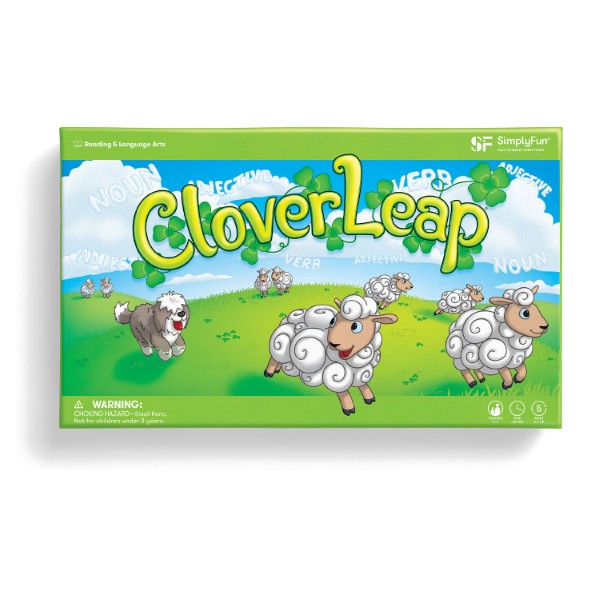
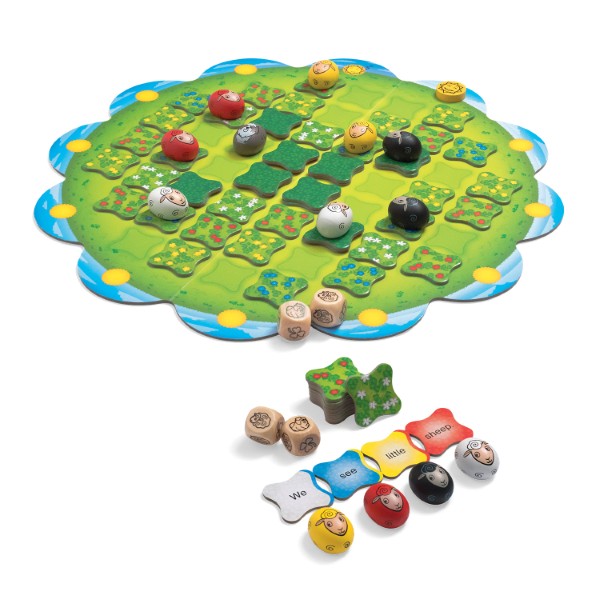
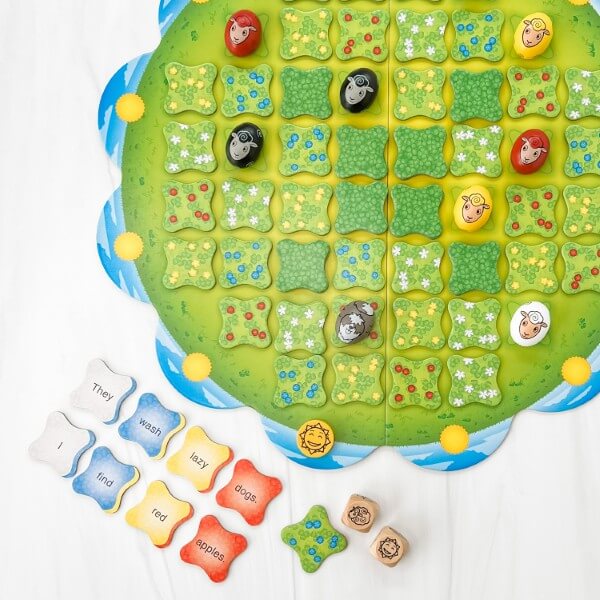
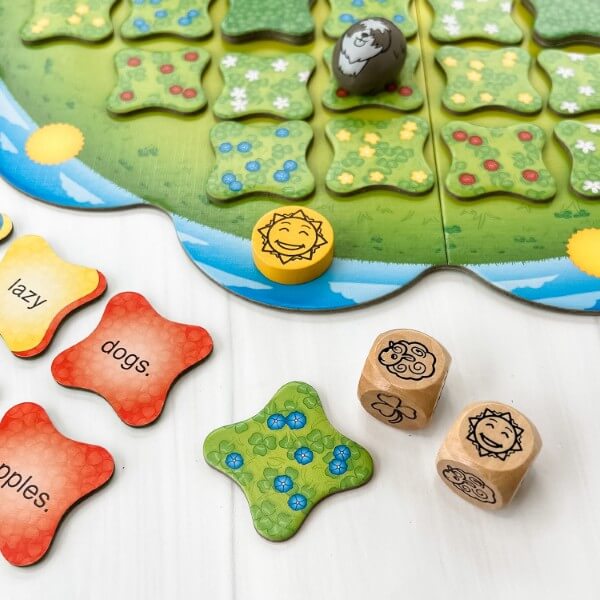
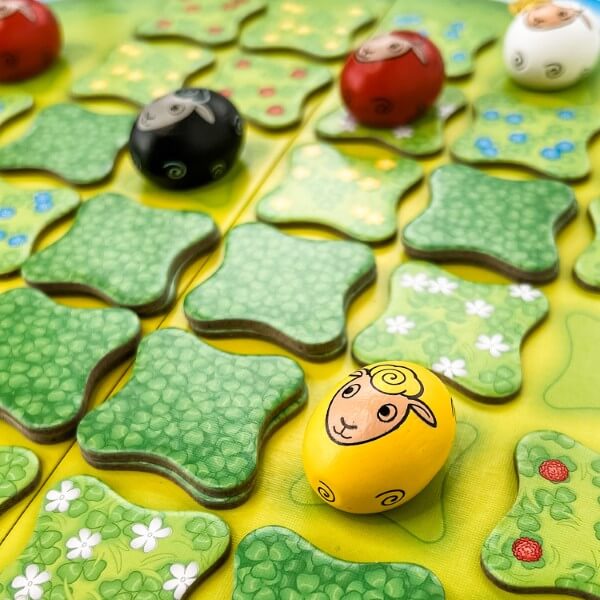
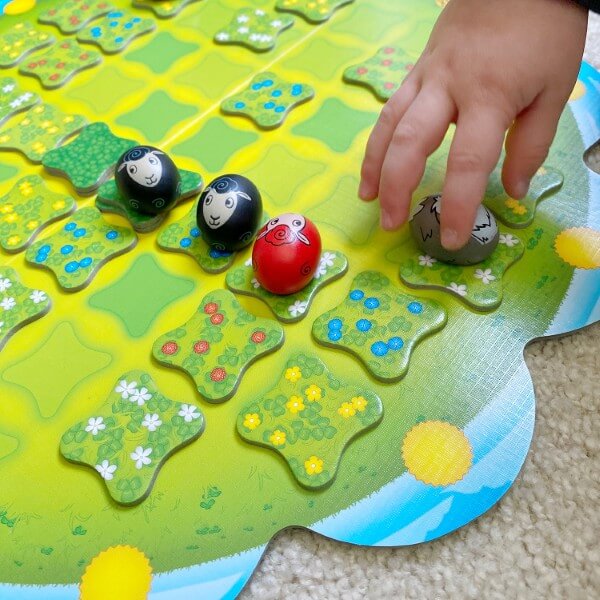

Collapsible content
This is a sentence-building game for 2 to 4 players ages 5 and up. Players guide a pair of sheep around the field of colored clover tiles trying to collect enough words to build complete sentences.
The game comes with 56 clover tiles that contain fully interchangeable parts of sentences. The tiles are each color-coded to help children sequence them correctly.
Clover Leap gives your children a step up on reading and vocabulary by building silly sentences. It introduces parts of speech: pronouns, verbs, adjectives and nouns while teaching basic sentence structure.
Place all the tiles face down on the game board, adding two dark green tiles on the eight darker spaces near the middle. The player who needs a haircut the most begins the game!
On your turn, throw both dice. Rolling a sheep symbol allows you to move one of your sheep around the board. Rolling a clover, allows your sheep to collect the tiles in the space where it's standing. The die symbol showing the sheep dog allows you to move the dog anywhere in the field, where sheep will then scurry away from it. And the die symbol showing the sun advances the Sun Marker around the outside of the board toward its final position, ending the game.
Every tile your sheep collect is worth a point. Note that the tiles have words printed on the bottom side. Players should try to collect a full set of all four colors to create a complete sentence to receive an additional bonus point! The wacky sentences are one of the best parts of this game.
When the sun completes the journey around the board, or there are no clover tiles left on the board, the game is over. The player with the highest score wins.
Very young kids may not immediately grasp the concept of sentence structure, but can still understand the set-collecting goal: get one of each color, and sequence them by joining tiles using the color-coded edges.
So that's how Clover Leap is played. This game brings together learning and fun in a totally unique way. I hope you enjoy playing it.

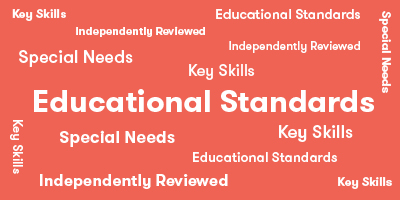
Core Standard*: Language
Reading
- Literature
- Craft & Structure Grade Levels K and 1st
- Informational Text
- Key Ideas & Details Grade Level K
- Foundational Skills
- Print Concepts Grade Levels K and 1st
- Phonics & Word Recognition Grade Level K
Speaking and Listening
- Comprehension & Collaboration Grade Levels K and 1st
Language
- Conventions of Standard English Grade Levels K and 1st

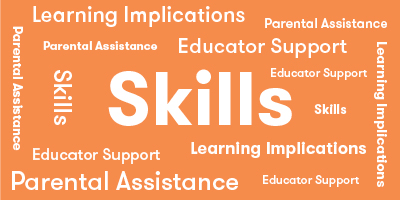
Explore
What Does Child Do To Use Skill In The Game?
Players explore directional movement, sentence completion and sequencing. Learning how to block another player is also explored.
How Parents Can Assist Learning
Parents can guide children to understand how the directional movements can help form a sentence. First model and talk about what you are doing and why. Then comment on the child's play. ("You need one clover of each color to make a sentence. What will happen if you go this way? How about this way? Which one do you need?")
Learning Implications and Educator Support
Educators can demonstrate how the color pattern sequence in the game makes a sentence. Have children arrange the colors in the same sequence pattern, then turn them over and read their funny sentences. This introduces the intent of the game and some practice to motivate children to move their sheep to make this pattern. Point out the subject, verb, and descriptive words in each sentence.
Determine
What Does Child Do To Use Skill In The Game?
Players determine how to combine tiles in correct sequence and how pieces move on the board.
How Parents Can Assist Learning
Parents can help children learn to use cues like the color edges on the tiles. They can also remind them of the sequence they are trying to get.
Learning Implications and Educator Support
Educators can help children learn to use cues like the color edges on the tiles to guide them in finding the words to make a sentence. Children can also be encouraged to determine what the letters, sounds, or words are on each tile.
Compare
What Does Child Do To Use Skill In The Game?
Players will note similar colors and shades of colors. When making sentences they will associate words with meaning. They will also compare the number of tiles each child has accumulated. Children compare moves in relation to color and pattern sequence.
How Parents Can Assist Learning
Parents can help children compare colors and amounts of various tiles for each player. They can also compare sentences to see which are funnier or make the most sense.
Learning Implications and Educator Support
Educators can compare types of words as they are turned over. "Great! You got an action word "race." That is called a verb. Now you've got a subject "mice," also called a noun. Use correct terminology to help children learn how to classify the vocabulary of literacy.
Remember
What Does Child Do To Use Skill In The Game?
Children remember colors, sound-letter association, and sight words.
How Parents Can Assist Learning
Encourage children to move the words around. Parents may need to read the words for them. Also encourage them to make a sequence (sentence) they recognize as making sense. Guide children to understand the importance of moving on the board to gain different colors of tiles.
Learning Implications and Educator Support
Educators can ask children to identify letters on the tiles and the sounds associated with these. Children may recognize some familiar words as well. See if children can remember the color sequence they need for a sentence.
Predict
What Does Child Do To Use Skill In The Game?
Players who understand the purpose of the game will hypothesize that certain moves will gain them needed tiles for more points.
How Parents Can Assist Learning
Parents can discuss and help make plans for moves with children until they have mastered game sufficiently to play on their own.
Learning Implications and Educator Support
Educators can ask children to predict where a player will move his/her sheep. This encourages children to pay attention to other player's moves and what tiles they have already acquired or need.
Plan
What Does Child Do To Use Skill In The Game?
Strategy involves planning how to use the dog to block other players from gaining the tiles they need. Strategy also involves planning to obtain needed tiles.
How Parents Can Assist Learning
After making several sentences with the tiles prior to playing the game, children should understand the color sequence. Parents can ask the child to identify a path with the needed color sequence on the board. This practice will help them plan their moves in the actual game.
Learning Implications and Educator Support
Educators can prompt children to think ahead. Encourage children to look at their options and plan their moves to gain what they need or to stop others from getting what they want. Model by saying something like, "My sheep already has blue flowers to eat, I need yellow flowers. Which way should I go to get yellow flowers?"
Experiment
What Does Child Do To Use Skill In The Game?
Experimentation is not part of the game, but can be encouraged before or after the game.
How Parents Can Assist Learning
Parents can encourage children to arrange their word tiles in different ways to make funny sequences.
Learning Implications and Educator Support
Educators can help children prepare for the game by letting them combine tiles in random sequences. Then read the tiles and see if they make sentences. Pull out the sequences that all agree are sentences. What is the same about them?
Practice
What Does Child Do To Use Skill In The Game?
With practice players will understand how to get different colored tiles and how to sequence them. They will also learn the components of a simple sentence.
How Parents Can Assist Learning
Before or after playing the game have "contests" to make the most sentences, the funniest sentences, or the longest sentences. All must agree that each is a sentence.
Learning Implications and Educator Support
Prior to playing the game educators can let children pick out tiles they want to make their own sentences. After playing the game, the educator can also encourage children to rearrange and make new sentences with the tiles they have won. This will give them more practice in sequencing words in a specific structure.
Solve
What Does Child Do To Use Skill In The Game?
Players solve the problem of how to make a sentence using a subject, verb, modifier and object. Players figure out how many points they made based on how many sentences and tiles they gathered.
How Parents Can Assist Learning
Parents can explain that the sentences in this game need a first word that is "who," a second word that is "what's happening," a third word that is "what kind of," and a last word that is "what." Encourage children to count their own points. Remind them they get a bonus point for a 4-tile sentence. For children who are not at this level, parents can focus on children getting the 4- colorsequence pattern.
Learning Implications and Educator Support
Educators can explain that the sentences in this game need a first word that is "who," a second word that is "what's happening," a third word that is "what kind of," and a last word that is "what." Encourage children to count their own points. Remind them they get a bonus point for a 4-tile sentence.
Review
What Does Child Do To Use Skill In The Game?
As the Players play, they can review their sentences and change them if they want.
How Parents Can Assist Learning
Parents can model by reviewing what they did for the child to see and hear. This helps children hear other's reasoning.
Learning Implications and Educator Support
Educators can ask children to identify what they did in a move and why. In this way, children learn how others think and plan and may learn from each other. The educator can also review the goal of the game and what is needed for a sentence.
Demonstrate
What Does Child Do To Use Skill In The Game?
Players share their words and sentences with all the players.
How Parents Can Assist Learning
Parents can ask children to read their words or sentences. If they cannot read, they can identify the words they remember in their group of tiles earned.
Learning Implications and Educator Support
Educators can ask children to demonstrate their knowledge of letters, sounds, and words as well as their memory the purpose of each word in a sentence.
Imagine
What Does Child Do To Use Skill In The Game?
This is not part of the game, but can be encourage after playing the game.
How Parents Can Assist Learning
Parents can encourage children to make up their own sentences with the tiles.
Learning Implications and Educator Support
Educators can encourage children to use the tiles from the game to create their own sentences. Children can work together to help each other.
*Data compiled from CCSSI ELA Standards, WA Science Standards, and Washington Social Studies Standards

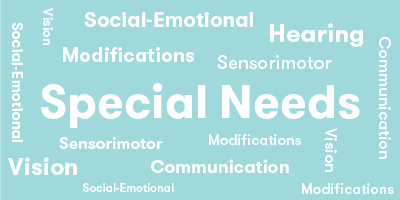
Cognitive
Suggestions for How to Modify Play Experience
Use a sheet of typing paper and have the child trace a tile four times across the top of the paper in a row. Then give the child markers, crayons, or colored pencils to color the first one white, the second one blue and the third one red. (This is also good fine motor practice.) These traced tiles will serve as color cues for what colored clover children need to gather and where they should put their tiles. It is also a visual cue for the sentence sequences. Children with cognitive delays benefit from sequence charts to guide their thinking. As play proceeds the adult can remind the child to put the pieces under the same colored tile. They can also suggest the child check the paper to see what other colors s/he needs to gather. At the end of the game the sheet can serve as a worksheet for counting the child's score (as in the model in the directions).
Omit the dog for children with cognitive delays. This is a complication that will make the game more difficult to follow..
Take all of the yellow tiles out of the game. This eliminates all modifiers and makes is easier for children with cognitive delays to make a sentence.
Communication
Suggestions for How to Modify Play Experience
If children can read, encourage them to read their words and choose which words they want in their sentence. (Use the visual guide mentioned in cognitive above as a guide.) If they cannot read, parents can ask children to name the letters on the tiles. The parent then reads the tile and says, "Now you read it." (The child repeats what the parent said, but feels like they are reading.) The child is learning to associate text with actual words and this is a motivation to learn to read.
Label the direction the child is moving to help them learn directional vocabulary. After several times, ask, "Did you go right or left?"
Sensorimotor
Suggestions for How to Modify Play Experience
This game has many small pieces that move easily on the board and may be difficult for children with fine motor skills to manipulate. If this is the case, the adult or another player can move where the child instructs them. This player then hands the child the tile so they can place it on the table. This child may also be the Sun Mover, who can move the sun around the edge of the board.
At the end of the game read all of the sentences and have each child decide which is their favorite sentence and why.
Social Emotional/Behavioral
Suggestions for How to Modify Play Experience
Encourage children to watch each others' play and offer comments about the options. For example, "you have every color but yellow. Is there a yellow close to your sheep?"
Vision
Suggestions for How to Modify Play Experience
This game has many small pieces that make seeing individual tiles difficult for children with vision problems. Children with vision problems may want to be the Dice Tosser and tell each player what to do on the board.
Hearing
Suggestions for How to Modify Play Experience
No modifications required
*Data compiled from CCSSI ELA Standards, WA Science Standards, and Washington Social Studies Standards

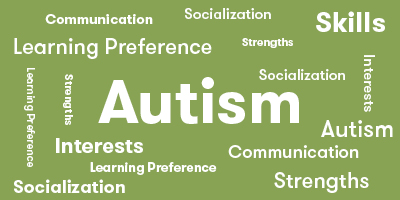
Autism Strengths & Interests
Short Summary of Strengths & Interests
- Lining up and sequencing things Enjoys manipulating small.
- Enjoys manipulating small objects such as building blocks or tiles on a game board.
- Likes collecting things.
Is good at matching visual items
This game is not appropriate
Has a good memory for sensory details, including visual, touch, taste and smell
This game is not appropriate
Has a good memory for words, phrases and dialouge
This game is not appropriate
Has a good memory for pictures, numbers and patterns
This game is not appropriate
Likes to put things in order or a sequence
Is This Game Appropriate? Yes
Description
Clover Leap is a good game for children who like sequencing items. The game requires children to move their cute sheep around the board collecting colored tiles that correspond to different parts of speech. Children collect one of each of four colors to make crazy sentences.
Learns through visualizing or "replaying" actions in their mind
This game is not appropriate
Likes activities with rules, such as math and phonics
This game is not appropriate
Is very concrete and literal
Is This Game Appropriate? Yes
Description
Some children prefer activities that are very literal. For those children, Clover Leap can be a good match. Each roll of the die has a clear correspondence to an object, sheep, sheepdog and sun, on the game board to move. Also, the construction of the sentences is based on color matching, which is also a literal activity.
Learns in small "chunks" (for example, phone numbers are 3 chunks of number xxx-xxx-xxxx that are combined together)
This game is not appropriate
Is good at nonverbal reasoning and logic
Is This Game Appropriate? Yes
Description
Likes spatial problem solving
Is This Game Appropriate? Yes
Description
Children may be very good at spatial problem solving. Those children can use problem solving skill in Clover Leap as they identify colors they need to complete a sentence and try to move their sheep to reach those colors.
Can read well with good vocabulary, though may not fully comprehend content
Is This Game Appropriate? Yes
Description
Clover Lead gives children practice reading simple words. It is a good game for developing reading comprehension as players make and read simple, crazy sentences. Adults can explain why each word (ex: verbs or nouns) is where it is in the sentence, while children learn about sentence structure
Likes to use and has good fine motor skill
This game is not appropriate
Likes established routines or set ways of doing things
Is This Game Appropriate? Yes
Description
Many children prefer routines and are good at following set ways of doing things. They will probably feel very comfortable with Clover Leap because the game play has very clear rules so that each turn plays the same way. They need to create simple sentences following the straightforward color coding system.
Likes manipulating, constructing or building things
This game is not appropriate
Likes to use and has good musical abilities
This game is not appropriate
Likes to use and has good drawing skills
This game is not appropriate
Autism Special Considerations
Appears to ignore other's communication and/or has difficulty giving eye contact to a communication partner
Is This Game Appropriate for Child with Characteristic? Yes
Can Child with Characteristic Play Game w/o Modification? Yes
Strategies for Developing Compensatory Skills:
Look at the game instead of each other.Player talking holds the object being talked about near their mouth to bring the child's attention to the object. This also shows the child how the words about the object are produced. For example, hold the picture on a game tile up by the mouth, and say the name of the object on the card. "My tile says, 'short.'"Rather than speak, sing communication between turns or when giving short directions. Music attracts the child's attention and interest.
Use unusual or exaggerated inflection to begin a communication about the game. This attracts the child's attention.
Has difficulty understanding complex verbal directions
Is This Game Appropriate for Child with Characteristic? Yes
Can Child with Characteristic Play Game w/o Modification? No
Strategies for Developing Compensatory Skills:
Break down directions into small steps. Don't go through all the directions at once.Combine short verbal instructions with visual and physical examples of each step. Use photos to illustrate what needs to be done. These can be taken ahead of time. The combination of pictures and actions reinforces learning the steps. Also, take pictures during the game for use in later discussions about the game and what happened.
Use hand-over hand guidance if needed, so children feel the actions as the directions are being given. This helps develop the child's memory for the correct movements. Gradually reduce the support as the game is learned.Check for comprehension by asking the child to show you what to do next.
Uses vocabulary inaccurately or demonstrates echolalia (repeating another's speech)
Is This Game Appropriate for Child with Characteristic? Yes
Can Child with Characteristic Play Game w/o Modification? No
Strategies for Developing Compensatory Skills:
Respond to immediate echolalia (repeating what was just said) by rephrasing the child's response into a correct format, so the child can hear and repeat that phrase. For example, assume you are playing with a child named Andy and you say, "Your turn," and Andy repeats, "Your turn." You can say, "It's Andy's turn. You say, my turn." This allows the child to hear and repeat the correct response. Eventually, the child will pick up the pattern of response.
Delayed echolalia (repetition of previously heard comments) may have a hidden meaning or association. Look for connection in the phrase used to the current situation. For example, the child says, "After these messages we'll be right back!" Think what the repeated phrase is associated with for the child. Try to interpret what is meant and rephrase it for the child. For example, you might respond by saying, "It sounds like you want a break for a few minutes. Is that what you mean? You can tell me, 'I need a break.'"
Gets stuck repeating a verbal topic or physical actions and/or has difficulty attending to others' actions or topic.
Is This Game Appropriate for Child with Characteristic? Yes
Can Child with Characteristic Play Game w/o Modification? No
Strategies for Developing Compensatory Skills:
Incorporate a preferred topic into the game to increase motivation. For example, if the child is fixated on a particular character, like a favorite super hero, ask what the character would do if they were playing? "Let's see what sentence Spider Man makes." Practice phrases for commenting on others' play actions. For example, you say to Joe (who is playing with you), "Right on! You made a sentence ." Then ask the child, "What did Joe do? " This gives the child a model that they can imitate.
Remind children about listening and watching others' before making their own comment or action.Use a motivation toy or object to gain the child's attention. For example, a preferred wind-up toy can be placed on the board when it is the child's turn. The child gets to wind up the toy after completing their turn.
Use the child's own finger to point to what needs attention. They will attend to their finger first, and then the adult can point out the object he is pointing at.Extend the child's action to make a correct response. For example, the child rolls two sheep and moves one sheep. The adult then says, you rolled two sheep (point to dice) and moved one (point to sheep moved). You can move this one again (point to it) or move this one (point to the other one) . Which one do you want to move?"Reinforce attention and actions by commenting on what was done correctly. For example, "You have a sentence!"
Has difficulty producing speech/communication
Is This Game Appropriate for Child with Characteristic? Yes
Can Child with Characteristic Play Game w/o Modification? No
Strategies for Developing Compensatory Skills:
Use augmentative communication, such as picture cards. For example, a picture of person pointing to another person means "your turn."
Use gestures and sign language to illustrate actions or concepts. For example, use the sign for 'finished' (two hands facing down, spread out from the middle of the body), point to the next player and say, "I'm done. It's your turn." The signs and gestures add a visual component to support understanding.
Extend the child's sounds into words or words into phrases to provide a model. For example, if the child says, "flow," you say, "Flower. That's right." Or, if the child says, "on," say, "Yes, you put the sheep on the red flowers."
Provide at least 10 seconds wait time for the child to process or produce responses. It may take longer to formulate a thought or response for children with special needs.
Has difficulty sequencing multi-step actions and/or doing complex abstract tasks
Is This Game Appropriate for Child with Characteristic? Yes
Can Child with Characteristic Play Game w/o Modification? No
Strategies for Developing Compensatory Skills:
Use physical actions to walk through steps numerous times, with less support for the final step each time. This is called "shaping." For example, walk through the steps of throwing the dice, moving a sheep, and turning over a tile numerous times in practice. Then do the first two steps and say, "What do you do next?"
Make picture cards of each step and option of a game, so the child can refer to the pictures as needed.Supplement board illustrations and pieces with additional tangible materials. For example, use plastic letters to spell out the words on the Clover Leap word cards. This gives children a tactile element in addition to a larger model, reinforcing the process.
When the child reads a tile, ask for an example or explanation of what is on the card to make sure child understands the vocabulary. For example, if the child turns over the tile "kites," pretend to be confused and ask," What is kite?" The child's explaining demonstrates the child's comprehension of the word on the tile. It also gives adults the opportunity to define or illustrate vocabulary the child may not know. Use real objects or pictures to illustrate concepts when possible.
Demonstrates difficulty initiating and maintaining social interactions
Is This Game Appropriate for Child with Characteristic? Yes
Can Child with Characteristic Play Game w/o Modification? Yes
Strategies for Developing Compensatory Skills:
Develop a social story to be read at the start of a game. A social story is a short booklet that illustrates how a child can use positive social skills. It includes two to five descriptive statements and a directive statement. For example: "When I watch others, I will know when it is my turn. Others like me when I take turns. I will watch what others do with their pieces and listen to what they say. Others like it when I talk about the game." Add photos or drawings of the child doing the actions described in the story.
Role play social situations and reinforce appropriate words and actions. For example, role play moving the dog up behind another player's sheep. What will that player do? Or, role play commenting on another player's turn. For instance, "What direction do you think they should move their sheep? What will they get?
Use video feedback of positive social behaviors. Video of actual play enables children to see what they or others did. Appropriate actions and interactions can then be discussed.
Acts out or demonstrates avoidance behaviors when frustrated, overwhelmed, or needs more sensory input.
Is This Game Appropriate for Child with Characteristic? Yes
Can Child with Characteristic Play Game w/o Modification? No
Strategies for Developing Compensatory Skills:
Reduce extraneous noise or allow the child to wear head phones or ear plugs if loud sounds cause anxiety.
A weighted vest worn during the game may provide additional pressure input and thus reduce fidgeting due to sensory needs. Pressure can be calming when used for no more than 20 minutes at a time.
Practice a phrase to ask for help and role play situations in the game where it is needed.Provide techniques for self-calming, such as holding a special toy.
Allow time for movement. For example, a child who needs to move frequently can be given an opportunity to 'celebrate' their turn by running around the table or jumping up and down 10 times.
Has short attention span for non-preferred activities
Is This Game Appropriate for Child with Characteristic? Yes
Can Child with Characteristic Play Game w/o Modification? No
Strategies for Developing Compensatory Skills:
Provide a break when needed.
Use "when...then" phrases. For example, "When you take your turn, then I'll let you play with your toy."Frequently remind the child of the goal of the game. "You get more points if you have one of each color to make a sentence. What do you still need?
Incorporate a motivating activity as part of the play. For example, each player gets to manipulate a fun 'fidget' toy, such as a stress ball or squeeze toy.
Needs sameness or consistent routines and/or has difficulty with transitions from one activity to another
Is This Game Appropriate for Child with Characteristic? Yes
Can Child with Characteristic Play Game w/o Modification? No
Strategies for Developing Compensatory Skills:
Play games at the same time every day, so the child anticipates the game routine.Change the location of the game, so the child may play in different rooms, at the table, or on the floor. This will build tolerance for variation.
Prepare the child ahead time for the introduction of a new game. Talk about aspects that will be motivating for the child, and let them explore the parts of the game before setting out the whole game.
Provide a structure for placement of game pieces that can be the same each time the game is played. For example, have a specific location for where the board goes, the pieces, etc.
Provide choices for how the child can be involved in set up or clean up. For example, you might say, "Do you want to put out the light green or dark green pieces? Involve the child verbally and with actions for the transition to the game table or at the end of game play. For example, you might say, "Let's look at the pictures on the game box and guess what it is about."
Use an object cue. Let the child hold an object from the game or activity you want to introduce prior to the transition. For example, if you were intending to play Clover Leap you might hand the child sheep and say, "Look here is a sheep. Let's see what we do with it in this game."
Has difficulty understanding others' feelings, intentions, and the reasons for others' actions.
Is This Game Appropriate for Child with Characteristic? Yes
Can Child with Characteristic Play Game w/o Modification? Yes
Strategies for Developing Compensatory Skills:
Model and point out what others are feeling and comment on their facial expressions or words.Discuss what causes feelings in others. For example, "You are happy because you have three of your favorite color. Joe's face is happy too. Why do you think Joe is smiling?"
Ask child to explain their own feelings and intentions.
Ask child to explain why other players did specific actions in the game.
*Data compiled from CCSSI ELA Standards, WA Science Standards, and Washington Social Studies Standards

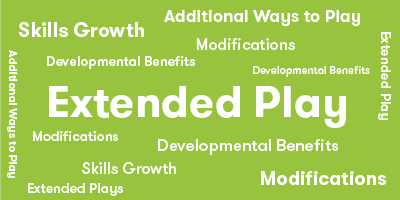
Extra Ways to Play the Game
Place 10-20 word discs (some of each color) upside down on the table. Pick up a word disc and start a story. The next person picks up a word disc and continues the story using the word they picked. Continue making up a story, no matter how zany.
Materials Needed
No additional materials needed.
Developmental Benefits
This game variation will develop language and narrative skills important for literacy. Encourage children to be imaginative with their story.
Extra Ways to Play the Game
Use the sheep markers and dog piece on the board for dramatic play. Add other small figurines (cows, wolf, people, etc.) to inspire a story that children can make up.
Materials Needed
No additional materials needed.
Developmental Benefits
Dramatic play helps children develop sequencing and narrative skills. In addition, children learn social interaction, dialogue and negotiation. Confidence in social interactions also derives from this type of play.
Extra Ways to Play the Game
Modify the game by giving one point for three-word sentences (with no modifier) and two points for four-word sentences. Give extra points for the funniest sentences.
Materials Needed
No additional materials needed.
Developmental Benefits
Children can benefit from understand simple versus more complex sentences. This modification can help them understand the basic sentence format.
*Data compiled from CCSSI ELA Standards, WA Science Standards, and Washington Social Studies Standards
Game Details
- Game Board
- 56 Clover Tiles
- 8 Sheep Pawns
- 1 Dog Pawn
- 1 Sun Tile
- 2 Dice
- 1 Rules Booklet
- Choosing a selection results in a full page refresh.
- Opens in a new window.










